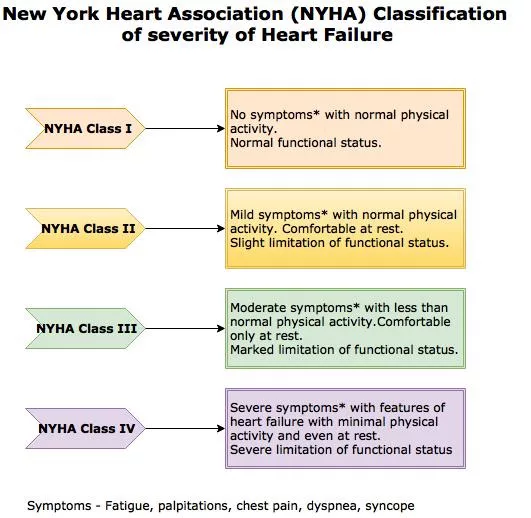There are different types of heart failure. It can be chronic (the disease sets in gradually, with symptoms worsening more slowly), or acute (the onset is rapid, or even sudden). There are also different stages of the disease, ranging from mild to severe, each characterized by specific symptoms and a distinct impact on quality of life.
What are the different stages and classes of heart failure ?
At the most advanced stage, the disease is irreversible.
The different stages identify the progression of the disease. Each class corresponds to a degree of severity and gravity of the disease’s symptoms. They were established by the New York Association (NYHA) and are a reference for healthcare professionals.
Stage A (or NYHA I) identifies people who do not yet have symptoms or heart disease. However, risk factors play an important role in the more or less rapid development of the disease.For example, diabetes, obesity, hypertension, coronary heart disease… These conditions can increase the risk of acute heart failure.The patient has no physical activity limitations.
Stage B (or NYHA II) corresponds to pre-heart failure. Symptoms of heart failure are not fully present, but the heart is damaged by structural heart disease or another risk factor. This stage is manifested by an absence of symptoms at rest, but fatigue, palpitations or shortness of breath during physical activity.
Stage C (or NYHA III) means that the patient has symptoms of heart failure with objective evidence of a structural or functional abnormality of the heart at rest. Symptoms are clearly present during daily activities such as walking.
The last stage (D) (or NYHA IV) is the highest stage and heart failure is advanced. The patient’s symptoms are such that they interfere with the functions of daily life (walking, breathing) and lead to repeated hospitalizations. Physical activity then represents a “pain” for the patient.


The importance of early diagnosis
Heart failure causes 70,000 deaths in France every year. This figure is rising steadily as the population ages. To optimize the quality of life of heart failure patients, early diagnosis of the disease is essential. In 2021, the OPTIM’IC program was launched by healthcare professionals to call for systematic early detection of heart failure. For the patient, early diagnosis will enable the initiation of appropriate and effective treatment, as well as medical follow-up with the aim of improving life expectancy.
However, there are still a number of problems that prevent treatment from being optimized for all patients, such as non-visible care channels and a lack of nursing staff for consultations.
Prevent heart failure
To prevent the disease, a number of lifestyle changes are called for. Indeed, the World Health Organization recommends regular physical activity (30 minutes a day), a balanced diet with reduced salt and sugar intake, and regular medical check-ups.
Today, heart failure is a major public health issue, and it is for this reason that prevention strategies need to be put in place by recognized organizations in France.

Stay informed and follow our news on our Linkedin page : https://www.linkedin.com/company/procope-medicals/
Sources :
https://www.heart.org/en/health-topics/heart-failure/what-is-heart-failure/classes-of-heart-failure https://theconversation.com/insuffisance-cardiaque-comment-la-prevenir-comment-la-traiter-170822 https://www.cardio-online.fr/Actualites/Depeches/Insuffisance-cardiaque-systematiser-le-depistage-precoce-parmi-les-pistes-pour-optimiser-le-parcours-de-soins https://www.femmeactuelle.fr/sante/sante-pratique/insuffisance-cardiaque-les-differents-stades-de-la-maladie-2150748
